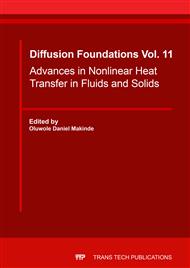[1]
A.A. Lacey and G.C. Wake, Thermal ignition with variable thermal conductivity, IMA J. Appl. Math. 28 (1982) 23-39.
DOI: 10.1093/imamat/28.1.23
Google Scholar
[2]
R. S Lebelo, O.D. Makinde, Numerical investigation of CO2 emission and thermal stability of a convective and radiative stockpile of reactive material in a cylindrical pipe, Adv. Mech. Eng. 7 (2015) 1–11.
DOI: 10.1063/1.4898446
Google Scholar
[3]
O. D. Makinde, M.S. Tshehla, Analysis of thermal stability in a convecting and radiating two-step reactive slab, Adv. Mech. Eng. (2013) 1 – 9.
DOI: 10.1155/2013/294961
Google Scholar
[4]
B.H. Hamza, E.S. Massawe, O.D. Makinde, Analysis of transient heating due to exothermic reaction in a stockpile of combustible material, Int. J. Phys. Sci. 6(18) (2011) 4337 – 4341.
Google Scholar
[5]
R.S. Lebelo, Thermal Stability Investigation in a Reactive Sphere of Combustible Material, Adv. Math. Phys. (2016) 1 – 9.
Google Scholar
[6]
O.D. Makinde, Hermite–Pade_ approach to thermal stability of reacting assesin a slab with asymmetric convective cooling, J. Franklin Inst. 349 (2012) 957 – 965.
DOI: 10.1016/j.jfranklin.2011.12.001
Google Scholar
[7]
E.J. Davis, B. H. Hampson, B. Yates, Analysis of the development of runaway in Powders, Inst. Che. Eng. Sym. 68 (1982) 1-19.
Google Scholar
[8]
A. Arisoy, B.B. Beamish, E. Cetezen, Modelling spontaneous combustion of coal, Turk. J. Eng. Environ. Sci. 30 (2006) 193 – 201.
Google Scholar
[9]
F.S. Dainton, Chain reaction: An Introduction, Wiley, New York, (1960).
Google Scholar
[10]
R.S. Lebelo, O.D. Makinde, Modelling the impact of radiative heat loss on CO2 emission, O2 depletion and thermal stability in a reactive slab, Trans. Mech. Eng. 39 (2015) 351-365.
Google Scholar
[11]
J.M. Simmie, Detailed chemical kinetic model for the combustion of hydrocarbon Fuels, Prog. Energy Comb. Sci. 29 (2003) 599-634.
DOI: 10.1016/s0360-1285(03)00060-1
Google Scholar
[12]
C.K. Westbrook, Mechanism reduction and generation using analysis of major fuel consumption pathways for n-heptane in premixed and diffusion flame, Proc. Comb. Inst. 28 (2000) 1563-1577.
Google Scholar
[13]
R. L Burden, J. Douglas-Faires, Numerical Analysis, ninth ed., Brooks/Cole, Boston, (2011).
Google Scholar
[14]
J.J.E. Cartwright, O. Piro, The dynamics of Runge–Kutta methods, Int. J. Bifurcation Chaos. 2 (1992) 427-449.
DOI: 10.1142/s0218127492000641
Google Scholar
[15]
H. Zhao, J. Gao, Z. Chen, Stability and numerical dispersion analysis of finite-difference method for the diffusive-viscous wave equation, Int. J. Num. Anal. Mod. 5 (2014) 66-78.
Google Scholar
[16]
T.W. Davies, Biot Number, Thermopedia: A-to-Z Guide to Thermodynamics., DOI: 10. 1615/AtoZ. b. biot_number, (2011).
Google Scholar


